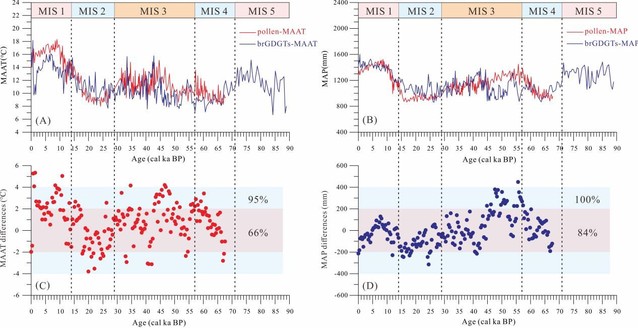Liping Tian a, b, 1, Mengyuan Wang c, d, 1, Cong Chen b, *, Xiao Zhang b, Zhuo Zheng b, d, Meiling Man e, Kangyou Huang b, d, Li Li a, Guodong Jia a, d, *
a State Key Laboratory of Marine Geology, Tongji University, Shanghai, 200092, China
bSchool of Earth Sciences and Engineering, Sun Yat-sen University, Zhuhai, 519082, China
cSchool of Marine Sciences, Sun Yat-sen University, Zhuhai, 519082, China
d Southern Marine Science and Engineering Guangdong Laboratory (Zhuhai), Zhuhai, 519082, China
e Department of Physical and Environmental Sciences and Environmental NMR Centre, University of Toronto Scarborough, Toronto, ON M1C 1A4, Canada
Abstract
Branched glycerol dialkyl glycerol tetraethers (brGDGTs) are a type of bacterial membrane lipid that are ubiquitous and robust for inferring paleoclimate evolution in continental settings, especially for paleotemperature. They can be engineered to show differential responses to ambient conditions under different settings, making setting-specific brGDGTs-based calibrations, mostly being linear models, preferable for paleoclimate reconstructions. However, even such a cautious approach is challenging given the allochthonous inputs and changing sedimentary settings that were inevitable in the geological past. In this study, a method called Locally Weighted Weighted Average-Partial Least Squares Regression (LWWA-PLS) commonly used in pollen-based reconstructions was introduced to address this challenge. In the latest modern global brGDGTs dataset from all archives known to host brGDGTs (n = 3068), we found that the LWWA-PLS model had high credibility in predicting environmental parameters (temperature, precipitation and pH) and that the average accuracy in estimating the contribution of brGDGTs in a sample from different environments (soil, peat, and subaqueous) reached 81%. Based on brGDGTs in two lacustrine sediment cores exhibiting multiple deposition settings since 90 and 70 cal ka BP, the LWWA-PLS model was able to generate results comparable to those from pollen-derived paleorecords and better than those derived from linear models. This is especially true for the mean annual air temperature reconstruction. Moreover, the LWWA-PLS model successfully estimated the contribution of brGDGTs from different sources, which was generally consistent with the sedimentary facies of the two sequences. Overall, the LWWA-PLS model based on the global brGDGTs dataset is expected to advance the applicability of brGDGTs to complicated terrestrial environments.
Full Article:https://doi.org/10.1016/j.quascirev.2024.108540



